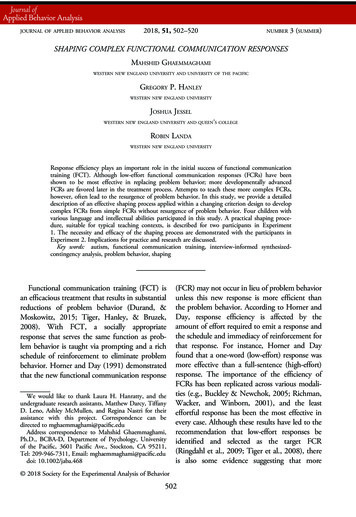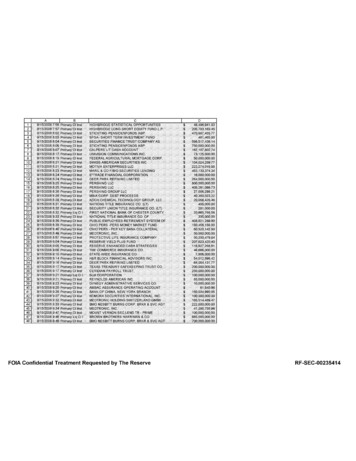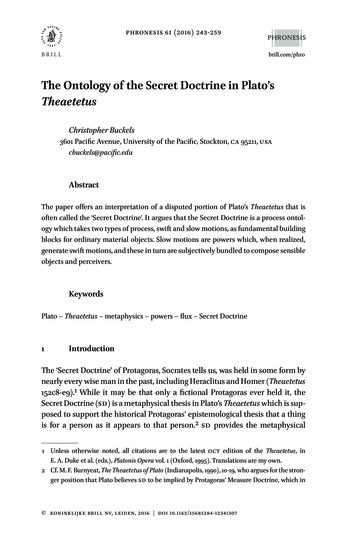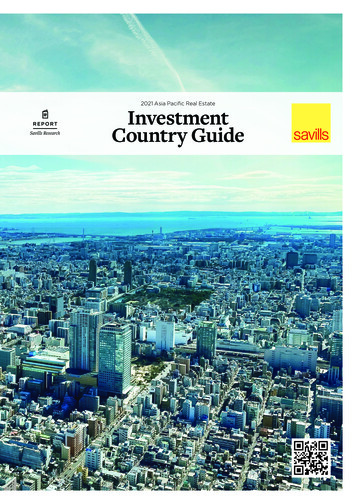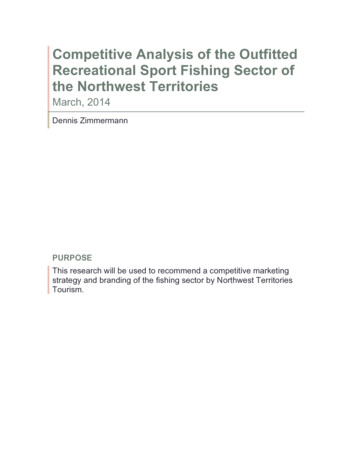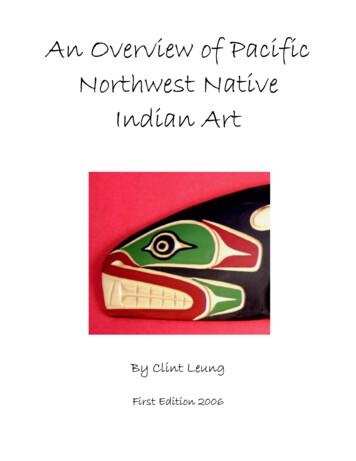
Transcription
An Overview of PacificNorthwest NativeIndian ArtBy Clint LeungFirst Edition 2006
An Overview of PacificNorthwest Native Indian ArtBy Clint LeungFirst Edition 2006Brought to you byYÜxx fÑ Ü à ZtÄÄxÜçExquisite Pacific Northwest Native Indian & Inuit Art Treasureshttp://www.FreeSpiritGallery.ca 2006 Clint Leung
Important NoticeThis eBook comes with resell rights which allow anyone to resell or freely distribute the eBookin its entirety. However, the contents of this eBook must be left intact and not be altered in anyway. The addition of links and ads are permitted at the end of the document only.Individual chapters and sections of this eBook on their own are not allowed to be published,reprinted or posted on ezines and other websites. However, there are similar individual articlesavailable written by the same author which can be freely used by webmasters. To access thesearticles, see the following articles.comDo an article search under the author, Clint Leung, which will generate a list of similar articles.The use of these specific articles must be in accordance with the rules of the above websites.To tell a friend about this eBook, go to ee Spirit Gallery – http://www.FreeSpiritGallery.caAn Overview of Pacific Northwest Native Indian Art 2006 Clint Leung. All Rights Reserved.
Table of ContentsForeword . . . . . 1The Basic Elements of Pacific Northwest Native Indian Art . . 2The Colors of Pacific Northwest Native Indian Art . . 3The Shapes & Form of Pacific Northwest Native Indian Art . 4Pacific Northwest Native Indian Art Animal Design . 7The Region of Pacific Northwest Native Indian Art . 9Pacific Northwest Native Indian Totem Poles . 10Pacific Northwest Native Indian Tribal Masks . . 12The Thunderbird in Pacific Northwest Native Indian Art 14The Bear in Pacific Northwest Native Indian Art . . 16The Eagle in Pacific Northwest Native Indian Art . . 17The Killer Whale in Pacific Northwest Native Indian Art . . 18The Raven in Pacific Northwest Native Indian Art . . 19The Salmon in Pacific Northwest Native Indian Art . . 20Pacific Northwest Native Indian Art Authenticity . . . . . 22Tips on Buying and Shopping for Authentic Carvings . 24Interior Decorating and Pacific Northwest Native Indian Art . . 26Profile of Carver Gary Baker 27Profile of Carver Peter Charlie . 29Profile of Carver Cody Mathias . 31Profile of Carver Paul Joseph . 33Additional Resources . 35
ForewordI had lived in Vancouver very briefly as a child and it was during that time when I was firstexposed to the art of the Northwest Coast Native Indians. It was the towering colorful totempoles out in Stanley Park that everyone gazed at with wonder and appreciation. It took about 30years later during a return trip to Vancouver when Pacific Northwest Native Indian art caught myeyes again.I was in Vancouver for business and landed at the city's new airport terminal. One could not helpbut notice the huge native carvings near the arrivals area. Later on during my stay, I decided towander around in the Gastown district. It was in these shops and galleries in Gastown where I fellin love with Pacific Northwest Native Indian art. I saw many wonderful wooden plaquesrepresenting different animals. There were also art prints, paintings, masks, wooden bowls andeven furniture with these animals either painted or carved right into the pieces.The colors and designs, which might be considered a bit exaggerated to non-native eyes, werestriking as well as bold. I knew at that time that I wanted to include some of this magnificentartwork on my walls back at home. So I bought two plaque carvings and carried them home likenewly found treasure.Historically, the Native Indians who lived along the river valleys and coastal waters of the PacificNorthwest were all hunters and gatherers. The region was blessed with abundant resources fromboth the seas and forests. These people captured in their artwork the animals they hunted andobserved. These included bears, killer whales, eagles, ravens, salmons, wolves, hummingbirdsand even frogs. Chiefs and mythical characters important in their legends such as thunderbirdswere also included as art subjects.Pacific Northwest Native Indian art is just only recently gaining some major attention in somegalleries and museums around the world. Compared to other native arts such as Inuit (Eskimo),exposure of Pacific Northwest Native Indian art is still rather limited to the northwest coast ofCanada and the United States. This form of artwork is virtually unknown to most parts of theworld including many regions of North America. This will hopefully change as more people fromaround the world travel to Vancouver. The future winter Olympics in 2010 up in Whistler, BCwill also have a positive impact on the region's aboriginal art. I personally believe that PacificNorthwest Native Indian art has a lot of potential to be internationally recognized and accepted.This eBook will hopefully give the reader a good overview of what Pacific Northwest NativeIndian art is all about as well as what makes it so distinctive from other aboriginal arts. I hope tohelp the extremely talented Pacific Northwest Native Indian artists get more internationalexposure for their work with this eBook as well as through the Free Spirit Gallery website(http://www.FreeSpiritGallery.ca). After all, it would be a real shame if they had to stop doingtheir art in order to take up other jobs just to make ends meet.Clint Leung-1-
The Basic Elements of Pacific Northwest Native Indian ArtPacific Northwest Native Indian art is so distinct from other styles of Native American art thatmost neophyte admirers can probably easily spot a piece of aboriginal artwork that came from theNorthwest out of a crowd containing other native arts. The interesting thing is that they don’thave to really understand why Pacific Northwest Native Indian art is so easy to distinguish inorder to do this. There’s something unique and characteristic about the Northwest Indian stylesthat set them apart.The next few chapters will look into Pacific Northwest Native Indian art on a deeper level andillustrate some of its basic elements in order to give a better appreciation of this striking form ofart. Separate chapters explore different aspects of Pacific Northwest Native Indian art includingthe colors, shapes and designs used.Pacific Northwest Native Indian ArtPainting of Four Killer Whalesby Alex Underwood-2-
The Colors of Pacific Northwest Native Indian ArtThe main traditional colors of Pacific Northwest Native Indian art are black and red. Black is theprimary color used in the formline which is the outline for the body of the subject. The formlineis discussed further in the chapter about the shapes of Pacific Northwest Native Indian art.Although Native artists use commercial paint these days, black color was derived from charcoal,graphite or lignite coal in the old days. The secondary elements of the subject are usually paintedred. Red colors were derived from red ochre and hematite minerals before the days of paint.Many pieces of Pacific Northwest Native Indian art such as the raven and bear carving below useonly these two colors to achieve that characteristic Northwest Native look.Of course, many Pacific NorthwestNative Indian artists also use additionalcolors to add final touches to theirartwork. A tertiary color often used asa filler is blue-green where the shadescan range from pure blue all the way topure green. This was an influence fromthe Native Indian artists from thenorthern regions of the PacificNorthwest. Other colors that are usedas tertiary colors include yellow andwhite.Raven and Bear by Albert JosephBald Eagle by Cody MathiasContemporary Pacific Northwest Native Indian artists also occasionally experiment with othercolors since they are widely available today as commercial paints. There are also wood carvingsthat do not use any colors at all resulting in pieces with the stained natural wood look.In the past, black was painted first, then red and any tertiary colors came last. In many instances,black and red colors were painted on wood before any carving was started since these two colorswere usually put on the plane surface of the piece. Any tertiary colors like blue-green, yellow orwhite were added in after carving. This method was thought to be more practical for some artists.However, most Pacific Northwest Native Indian artists today carve first and paint later. Clearshoe polish or oil is then applied to carvings to give an extra shine to the surfaces.-3-
The Shapes & Form of Pacific Northwest Native Indian ArtWith further analysis of Pacific Northwest Native Indian art, it can be realized that the differentshapes used by Northwest Native artists in their artwork are what produces the characteristicNorthwest look. Each of these main shapes is discussed below with examples shown fromauthentic artwork.The FormlineThe formline of Pacific Northwest Native Indian art is the main line that outlines the body of thesubject whether it is a person or animal. Different parts of the subject such as the head, joints andother body parts (arms, legs, wings, etc.) are defined by the formline. The formline is usuallyblack in color but can sometimes be red. The thickness of the formline itself can change atvarious places and contains all the other shapes used for a subject.The Ovoid ShapeThe ovoid is the most dominant shape in Pacific Northwest Native Indian art. It is like a roundedrectangle with inner tension pushing the top to form a convex, similar to the shape of a breadslice. The lower side is sometimes seen with a concave at the bottom. These oval like shapesvary in size proportions depending on the kind of subject or creature they are used to symbolizebut all ovoids have the same common qualities whether they are long and slender or fat andround. Larger ovoids may be used to form the head of a subject, eye sockets, major joints, wings,tails or fins. Smaller ovoids may be used to form joints, eyes, ears, noses or contain faces.Sometimes ovoids are used to help fill empty spaces and corners.Ovoids can be solid (completely color filled) or open with inside space. Inner ovoids are smaller,usually solid ones that go inside a larger open ovoid. Below are examples of this. Thecombination can be observed in the formation of eyeballs.Examples of Ovoid Shapes-4-
The U-Form ShapeThe second most common shape used in Pacific Northwest Native Indian art is the U-form. Asthe term suggests, they resemble thick letter ‘U’s with ends tapering to sharp points. Like ovoids,U-forms can vary in proportions but they all have the U shape. Larger U-forms are used tocontour the body of the subject and as part of the formline for tails or ears. Smaller U-forms areused as space fillers and even feathers of a bird. Multiple U-forms can also be stacked together torepresent tails or fins. Below are examples of Pacific Northwest Native Indian art U-forms.Examples of U-FormsA common variation of the U-form is the split U-form. This is where the U-form is split in themiddle with the inner U looking more like a ‘V’ that ends up with a point in the center. Split Uforms can also vary in proportion. They are used in ears, feathers and tails. Northwest Nativeartists also use split U-forms as space fillers in open spaces. Below are examples of PacificNorthwest Native Indian art split U-forms.Examples Split U-FormsQuite often, U-forms are used in conjunction with ovoids to form the arms, legs, ears and otherbody parts. The possibilities of what can be portrayed with just this ovoid and U-form shapecombination are enormous in the hands of talented Northwest Native artists. Two examples of anovoid and split U-form combination are below. Notice the one in the right utilizes two split Uforms, one stacked on top of the other.Examples of U-Form – Ovoid Combinations-5-
The S-Form ShapeAnother shape used by Northwest Native artists is the S-form. This shape is like the letter ‘S’with tapered ends. It is used as space fillers as well as parts of arms and legs. Multiple S-formscan also form a subject’s ribcage. S-forms are also used to connect different body parts of asubject. Below are examples of S-forms, including multiples.Examples of S-FormsThe L-form is also a shape used as a space filler as well as a connector. Anexample of the L-form shape is on the right.L-FormNorthwest Native artists use these various shapes and the formline to create their intendedsubjects. As these positive shapes are assembled in close proximity to each other, the spacesbetween them create negative shapes which also play an important role in the overall design.Good artists know that any changes made to the positive shapes will also affect the negativeshapes as well.As one looks at Pacific Northwest Native Indian art more closely, including the pieces shownthroughout this eBook, the different shapes discussed can be recognized. These shapes help giveeach piece that unique Pacific Northwest Native Indian look.-6-
Pacific Northwest Native Indian Art Animal DesignThis chapter looks at the design of various Pacific Northwest Native Indian art animals sincenative artists focus so much of their subjects on wildlife and mythical creatures.Most of the time, the entire body of the animal will be outlined by the formline but not always.Sometimes only the head, wing, tail or foot will be shown to represent the animal in a differentprofile.The design of an animal’s eyes usually consists of the eyeball in an ovoid or circular shape withthe eyelid drawn as a fine line around it. This line is tapered to points on opposite ends.Sometimes, the eyelid is drawn as a thicker, tapered shape rather than a line. Both the eyeball andeyelid are usually placed within a larger ovoid that represents the eye socket. Below are examplesof different Pacific Northwest Native Indian art eyes. Some artists have also been known to addin eyebrows for both animal and human subjects.Examples of Pacific Northwest Native Indian Art EyesEars are usually represented as U-forms and sometimes ovoids. The noses of animals can varygreatly from small ovoid nostrils all the way up to large, flaring snouts. The following examplesshow ears and noses from carvings of bears.Examples of EarsExamples of NosesTongues can also have a range of form and may be drawn protruding from the animal’s mouth orbeak. An interesting note is when a raven bird’s tongue includes a circular disc, the NorthwestNative Indian artist is portraying the bird as the Bringer of the sun, moon or fire.-7-
Extremities such as claws of birds, flippers of killer whales, feet of animals and hands of humanscan be a major part of a Pacific Northwest Native Indian art piece. The entire limb such as an armor leg often includes an ovoid as the main joint connecting to the body. Extremities and theirlimbs can sometimes be drawn quite minimally by Northwest Native artists. In these cases, theextremities would often be joined to the subject’s body via a bent line. This bent line, similar to ahinge, represents the flexed position of the limb. Below are examples of Pacific Northwest NativeIndian art limbs. The last photo on the right is an example where the limb is minimalized.Examples of Leg & ArmExample of FlipperExample of LegBird feathers are generally elongated U-forms that may have split U-forms within. Most wingsof birds utilize the ovoid and U-form shape combination where the ovoid is the joint and the Uform will have feathers attached to it. Bird tails are often similar with an ovoid serving as the tailjoint and multiple feathers extending from it. Below are examples of Pacific Northwest NativeIndian art bird parts with feathers.Examples of Wings & FeathersAs we look closer at Pacific Northwest Native Indian art pieces and notice the various basicelements such as colors, shapes used and how the different parts are put together, we get a muchgreater appreciation of the skills of these native artists. This helps us admire and enjoy thisaboriginal art form that much more.-8-
The Region of Pacific Northwest Native Indian ArtPacific Northwest Native Indian art is based on the cultures of the various groups of nativepeople who have inhabited the Pacific Northwest for generations. There are many tribes anddivisions of Northwest Natives but they all fall into six major distinct groups; Tlingit, Tsimshian,Haida, Kwaguitl, West Coast (Nootka) and Coast Salish.The geographical region of Northwest Natives starts from the southern parts of Alaska, extendsalong the Canadian west coast of British Columbia including Vancouver Island and goes down asfar as the northern parts of Oregon state. The maps below show this geographical region wherePacific Northwest Native Indian art comes from. The first map on the left shows where the entireregion is in relation to the North American continent while the map on the right displays the sameregion in greater detail. The six major groups of Northwest Natives are also shown in the secondmap.Most of the Pacific Northwest Native Indian art shown in this eBook is from the SquamishNation which is part of the Coast Salish group.-9-
Pacific Northwest Native Indian Totem PolesWhenever visitors travel in and around the Pacific coastlines of the US states of Washington,Oregon and the Canadian province of British Columbia, they will likely see totem poles. One ofthe main attractions at Vancouver's Stanley Park is its collection of totem poles. There are alsototem poles and other Pacific Northwest Native Indian art on display at the VancouverInternational Airport.Pacific Northwest Native Indian Totem Poles at Vancouver’s Stanley ParkThe totems had multiple Northwest Native figures carved on tall, western cedar poles. It wasintended to have each figure represent a meaning and overall, a totem pole told a real or mythicalstory. Sometimes the figures also represented a Northwest Native family's crest or coat of armsrecording their family history.The Kwakwak'wakw and Nuu-cha-nulth tribes made totem poles as giant human welcomefigures. The Coast Salish people in southern BC and western Washington state carved largehuman figures on poles to represent ancestors and spirit helpers. Memorial poles were oftenplaced on front of houses in honor of deceased chiefs. There were also mortuary poles made inthe nineteenth century which housed at the top, the remains of important individuals. In additionto free standing totem poles, there were also poles at the front of houses which also served asdoorways. Poles decorated with Pacific Northwest Native Indian art were also made insidehouses to support roof beams.- 10 -
The first Northwest Coast Native tribes who made totems were the Haida, Tlingit and Tsimshianin BC as well as southeast Alaska in the early 1800's (see previous chapter). Their use spread toother tribes in the Northwest coast region over the years. There were ceremonies referred to aspotlatches whenever new totem poles were raised. However, these potlatches were made illegalin Canada during the late 1800's. As a result, most Northwest Native tribes stopped makingtotem poles but still carved small models of poles for tourists. This anti-potlatch law wasdropped in 1951 and the Northwest Native people resumed carving totem poles again.Close Up of Totem PolesTotem poles have become one of the key symbols for the Northwest Native people. Totem poleshave been specially commissioned in recent times and erected in both public locations as well asfor private Pacific Northwest Native Indian art collections around the world. Foreign locationshave included Japan and Germany. Totem poles made in BC have also been installed in someCanadian embassies abroad to represent one of the cultural icons of Canada.- 11 -
Pacific Northwest Native Indian Tribal MasksMasks have played important roles in many aboriginal tribal cultures around the world. Some ofthe most colorful and striking tribal masks come from Pacific Northwest Native Indian art by theNorthwest Native people.Types of Pacific Northwest Native Indian MasksPacific Northwest Native Indian masks depict many different humans and animals includingmythical creatures from Northwest Native legends. Some masks were portrait masks where theywere made to portray specific persons. Animal masks had special meaning for certain clans sinceall members of a tribe were supposedly descended from specific animals. From a structural pointof view, there are generally three different types of masks. The single face mask is the simplestof the three and is carved from a single piece of red cedar wood. The second type is a mechanicalmask with movable parts. This type of mask was actually developed after Europeans introducedthe Northwest Natives to strings and hinges. The Northwest Natives then utilized this Europeantechnology to enable eyes and mouths of masks to open and close. The third type of PacificNorthwest Native Indian mask is the transformation mask which is also the most complex one.This type has an outer mask that can open up to reveal an inner second mask form. Sometimesthis inner mask form can even open up to reveal a third mask form.Obviously, having multiple layers result in more weight in the mask requiring a strong person towear it. One example of a transformation mask was a salmon as the outer mask which opened upto reveal the salmon bringer inside. The salmon bringer was a character which was said to godown to the bottom of the sea in an underwater canoe to bring the salmon fish up to the rivers.The Kwagiutl people used transformation masks of animals which opened up to reveal ancestormask forms inside. These particular masks were used to tell stories of ancestral origins.The carver must account for shrinkage and warping when sizing upmasks. Although the majority of Northwest Native masks are madeto fit a person's face, not all masks were made with this intention.Masks also come in miniature sizes as well as giant sized versionslike the ones on display at Vancouver's airport. Mask making isone of the more advanced projects in Pacific Northwest NativeIndian art and therefore only experienced carvers make them. Aswith other works of this aboriginal art genre, traditional forms andcolors were used on masks (see Basic Elements of PacificNorthwest Native Indian Art). In addition to painting, many maskshad other materials such as hair, feathers, gold, straw and skinadded in order to enhance the pieces or make them more realisticlooking.Undersea World Kingby Wade Baker- 12 -
The Function of Pacific Northwest Native Indian MasksPacific Northwest Native Indian masks were made for use in ceremonies and rituals. One suchceremony was the potlatch which was a festival that involved a chief of one tribe giving gifts to achief from another tribe. Tribal chiefs wanted to show off their wealth by giving the best gifts.People from both tribes at a potlatch ceremony would feast, watch the giving of gifts and enjoythe ceremonial dances. Specially trained dancers would wear the masks and act out stories orlegends. An interesting fact is that in many cases, the women and children were not allowed toknow the actual meanings of either the masks or the stories being acted out. They were justallowed to watch and enjoy the performances as entertainment. Masks were also used in secretsociety rituals for shamanism, war, conjuring and inducting young members into a tribe. Theserituals were often restricted to certain members of the tribe only.Wild Woman Mask by Cody MathiasMask by Cedric BillyToday, masks are still used in ceremonies including performances by Northwest Native groupsfor non-Natives and tourists. One can see these masks in some museums and galleries thatexhibit Pacific Northwest Native Indian art. Masks are some of the most sought after items bycollectors as a striking and colorful mask definitely makes a very interesting piece of home decor.Some more examples of masks can be found at http://www.FreeSpiritGallery.ca/masks.htm.- 13 -
The Thunderbird in Pacific Northwest Native Indian ArtThe thunderbird has been one of the most dominant icons in Native American art and legends. Infact, the concept of the thunderbird has been so popular that it has been used in the non-Nativeworld to name a classic automobile, liquor, a 1960's children's adventure television show (andsubsequent recent movie), a US Air Force squadron and is referenced in pop music (rememberthe word 't-bird' in 1950's rock and roll?). The thunderbird is one of the few cross-culturalcharacters in Native American mythology since it is found in legends of Pacific Northwest,Plains, and Northeastern tribes.The Native Indians of the Pacific Northwest Coast always lived along the shores and neverventured inland to the mountains. Legend has it that the thunderbird, a mighty God in the formof a giant, supernatural bird lives in the mountains. The Quileute tribe of Washington stateconsidered a cave on Mount Olympus as the home of the thunderbird while the Coast Salishbelieved it is located on the Black Tusk peak in British Columbia. It is thought that thethunderbird never wants anyone to come near its home. If Native hunters get too close, thethunderbird will smell them and make a thunder sound by flapping its wings. It would also rollice out of its cave and down the mountain with chunks breaking up into many smaller pieces.Thunderbird by Gary BakerThunderbird with Killer Whaleby Charles AugustSome tribes such as the Kwakwaka'wakw believe that their people once made a deal with thethunderbird for its help during a food crisis and in return, the tribe agreed to honor thethunderbird for all time by making its image prominent in their Pacific Northwest Native Indianart. This is why Northwest Native totem poles are often carved with thunderbirds withoutstretched wings at the top.- 14 -
The wingspan of the thunderbird was described to be twice as long as a Native Indian war canoe.Underneath its wings are lightning snakes which the thunderbird uses as weapons. Lightning iscreated when the thunderbird throws these lighting snakes or when he blinks his eyes that glowlike fire. Sometimes these lightning snakes are depicted in Native American art as having wolf ordog-like heads with serpent tongues. They are occasionally referred to as the thunderbird's dogs.Native American art portrays the thunderbird with a huge curving beak and prominent ears orhorns.The thunderbird is large and strong enough to hunt its favorite food which is the killer whale.The lightning snakes of the thunderbird are used during hunts out at sea for the killer whale.After capture, the thunderbird carries the killer whale back to the mountain to eat. According tolegend, the thunderbird and killer whale once battled so hard that entire trees were uprooted.This was the explanation why there are treeless prairie regions near the Pacific Northwest Coastmountains. The thunderbird and killer whale are often depicted together in Pacific NorthwestNative Indian art. A large example is at one by renowned carver Richard Hunt at one of the artexhibits at the Vancouver International Airport.The Squamish Nation in British Columbia, Canada has a thunderbird as their symbol. Theirthunderbird is portrayed as one of the special messengers of the Creator. The Squamishthunderbird is a symbol for strength as well as change with the three tail feathers representing thepast, present and future. In the talons of this thunderbird is a face of a lizard which representsspiritual protection for the people of the Squamish Nation.Thunderbird by Cody MathiasSquamish Nation’s ThunderbirdFor many people, Natives and non-Natives alike, the thunderbird has become a symbol of power,strength and nobility. Even the classic automobile of the same name was reintroduced as acontemporary version. See thunderbirds at http://www.FreeSpiritGallery.ca/nwbirds.htm.- 15 -
The Bear in Pacific Northwest Native Indian ArtThe Native American people have always had a special place in their hearts for the bear. Bearsare portrayed in Pacific Northwest Native Indian art on totem poles, plaques, drawings, masks,jewelry and many other artworks. The bear represents a symbol of power, strength, learnedhumility, motherhood, teaching, healing and even dreaming. Bears are respected by theNorthwest Native people for their human-like qualities. Bears in Pacific Northwest Native Indianart signify friendship and many are shown to be smiling.Bears, regarded as masters of the forests, are also special from an environmental point of viewbecause they are considered to be a part of the land shared by both bears and humans. Whateverhappens to bears will affect the environment which will also ultimately affect humans. Thisrelationship between bears and humans is depicted on giant bear-human masks as part of the artexhibits at Vancouver's International Airport.Also interesting is that according to Northwest Native mythology, bears change into their spiritbodies to allow their earthly bodies to revitalize during winter hibernations. By Northwest Nativetradition, a bear that is killed by hunters is taken to the house of the tribe's chief and treated like aguest of honor. Eagle down is sprinkled on the bear as a welcoming gesture. Dances and
In the past, black was painted first, then red and any tertiary colors came last. In many instances, black and red colors were painted on wood before any carving was started since these two colors were usually put on the plane surface of the piece. Any tertiary colors like
